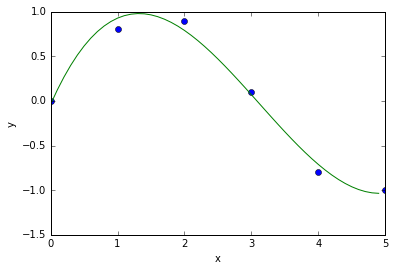Introduction To Python For Computational Science And Engineering
12 Dec 2016 | book
notes
python
Fangohr, Hans. Introduction to Python for Computational Science and Engineering, 2015.
Fangohr’s book is an excellent introduction to python. Coming from a Matlab background, the structure is easy to follow and very useful. The only negative about this book is that it was written for Python 2 and I am working in 3. This generally didn’t pose any problems, mainly just remembering that in 3 print() requires brackets. My notes can be viewed as a Notebook on GitHub, of which some of the more interesting parts are included below.
General Notes
- Use
help()with a command for details - Use
dir()with a command for a list of available methods
Chapter 2, A Powerful Calculator
import cmath
cmath.sqrt(-1)
1j
Chapter 5, Input and Output
- String specifiers, reprinted table below
- Pg 54-55 for a more elegant method of string formatting used in Python 3
fileobject.readlines()method returns a list of strings
## Copied from Fangohr 2015, page 52.
AU = 149597870700 #Astronomical unit in [m]
"%g" %AU
'1.49598e+11'
| Specifier | Style | Example Output for AU |
|---|---|---|
%f |
Floating Point | 149597870700.000000 |
%e |
Exponential Notation | 1.495979e+11 |
%g |
Shorter of %e or %f | 1.49598e+11 |
%d |
Integer | 149597870700 |
%s |
String | 149597870700 |
%r |
repr | 149597870700L |
hi
Chapter 8, Functional Tools
- Examples using the tools
filter,reduce, andlamda. - An anonymous function is only needed once or needs no name
lambda x : x**2(lambda x, y, z: (x + y) * z)(10, 20, 2)
- The map function applies function f to all elements in sequence s,
lst2 = map(f,s)map(lambda x:x**2, range(10))
- The filter function applies the function f to all elements in a sequence s,
lst2 = filter(f, lst)- The filet function should return a true or false.
filter(lambda x:x>5,range(11))
- List comprehension is an expression followed by a for clause, then zero or more for or if clauses. More consise then the above methods.
Chapter 12, Symbolic Computation
- SymPy is the Python Symbolic library, SymPy Homepage for full and up-to-date documentation
- Very slow compared to floating point opperation
- isympy an exexutable wrapper around python, convenient for figuring out new features or experementing interactively
- Rational type, Rational(1,2) represents 1/2.
- Rational class works exactly as opposed to the standard float.
- If Sympy returns the result in an unfamiliar form, subtract it with the expected form to determine if they are equivalent.
- Calculate definite integrals with a tuple containing the variable of interest, lower, and upper bounds.
- Results from dsolve are an Equality class, function needs to be evaluated to a number to be plotted.
preview()allows you to display rendered output on the screen- Automatic generation of C code via
codegen()
## Symbols
import sympy
x, y, z = sympy.symbols('x, y, z')
a = x + 2*y + 3*z - x
print(a)
print(sympy.sqrt(8))
2*y + 3*z
2*sqrt(2)
Differentiation
print(sympy.diff(3*x**4, x))
print(sympy.diff(3*x**4, x, x, x))
print(sympy.diff(3*x**4, x, 3))
12*x**3
72*x
72*x
Integration
from sympy import integrate
print(integrate(sympy.sin(x), y))
print(integrate(sympy.sin(x), x))
# Definite Integrals
print(integrate(x*2, x))
print(integrate(x*2, (x, 0, 2)))
print(integrate(x**2, (x,0,2), (x, 0, 2), (y,0,1)))
y*sin(x)
-cos(x)
x**2
4
16/3
Ordinary Differential Equations
from sympy import Symbol, dsolve, Function, Derivative, Eq
y = Function("y")
x = Symbol('x')
y_ = Derivative(y(x), x)
print(dsolve(y_ + 5*y(x), y(x)))
print(dsolve(Eq(y_ + 5*y(x), 0), y(x)))
print(dsolve(Eq(y_ + 5*y(x), 12), y(x)))
Eq(y(x), C1*exp(-5*x))
Eq(y(x), C1*exp(-5*x))
Eq(y(x), C1*exp(-5*x)/5 + 12/5)
Solving Non Linear Equations
import sympy
x, y, z = sympy.symbols('x,y,z')
eq = x - x**2
print(sympy.solve(eq,x))
[0, 1]
Chapter 15, Numerical Python (numpy): arrays
- The data structure,
array, allows efficient matrix and vector operation - An array can only keep elements of the same type, as opposed to lists which can hold a mix.
- Convert a matrix back tp a list or tuple using,
list(s)ortuple(s). - Computing eiganvectors and eiganvalues
- Numpy examples at SciPy.org
## Curve Fitting of Polynomial Example
import numpy
# demo curve fitting: xdata and ydata are input data
xdata = numpy.array([0.0, 1.0, 2.0, 3.0, 4.0, 5.0])
ydata = numpy.array([0.0, 0.8, 0.9, 0.1, -0.8, -1.0])
#now fit for cubic (order = 3) polynomial
z = numpy.polyfit(xdata, ydata, 3)
#z is an array of coefficients, highest first, i.e.
# x^3 X^2 X 0
#z=array([0.08703704, -0.8134, 1.693, -0.0396])
print("z = ", z)
#It is convenient to use `poly1d` objects for dealing with polynomials
p = numpy.poly1d(z) #Creates a polynomial function p from coefficients and p can be evaluated for all x then.
print("p = ",p)
#Create a plot
xs = [0.1 * i for i in range(50)]
ys = [p(x) for x in xs] # evaluates p(x) for all x in list xs
%matplotlib inline
import pylab
pylab.plot(xdata, ydata, 'o', label = 'data')
pylab.plot(xs, ys, label = 'fitted curve')
pylab.ylabel('y')
pylab.xlabel('x')
#pylab.savefig('polyfit.pdf')
pylab.show()
z = [ 0.08703704 -0.81349206 1.69312169 -0.03968254]
p = 3 2
0.08704 x - 0.8135 x + 1.693 x - 0.03968
